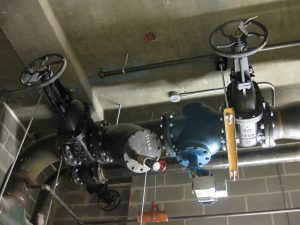MARKETING FOR PLUMBERS: 9 STRATEGIES TO GROW YOUR BUSINESS

Running a plumbing business has its unique challenges. Unlike other industries that can target a specific audience or rely on seasonal upticks, you need to reach two distinct markets all year round:
- The panicked customer with a burst pipe or other emergency who needs to find a nearby plumber ASAP
- The routine maintenance or install customer, who takes their time to research and compare plumbing companies to find the best fit for their project
To grow your plumbing business, you need marketing strategies to address both types of customers, all while competing in a crowded market.
We won’t pretend there’s a one-size-fits-all solution. The good news is, you can start small and still get great results.
Marketing for plumbers: where to start?
Online marketing is the best place to start because it’s easy to scale: you can reach a very wide audience with little cost and effort. (Versus offline marketing, which may require you to go door-to-door, pay for physical materials, and invest a lot of time.)
Even if you’re just starting your plumbing business and have zero experience with digital marketing, you can get started without hiring an expensive agency. The plumbers we spoke with said they don’t spend any money on SEO.
The nine best plumber marketing strategies for any stage of your business are:
- Claim your Google Business listing
- Create a plumbing website that converts
- Set up a Facebook page
- Gather and manage online reviews
- Use call-only ads
- Create expert plumbing content
- Get more leads with work requests
- Use customer service as a marketing tool
We’ll show how these strategies can address ‘emergency market’ and the ‘researching market’ so you can grow every aspect of your plumbing business.
Before we get into these strategies, let’s nail down some plumber marketing fundamentals.
Plumber Marketing Fundamentals
You probably didn’t start your plumbing business to sit behind a computer all day and analyze ad traffic. That’s okay, because marketing is much more than that!
In fact, you probably know more about marketing than you think: coming up with you plumbing business name and logo, spreading the word to friends and family, and asking existing customers for referrals are all solid marketing practices.
To get the most out of your marketing efforts, we suggest you start at the very beginning: your brand.
“We started out just making sure we have our branding in place,” says Paige Grover, who started an award-winning plumbing business from scratch in under 3 years. “An eye catching logo and tagline. Then it was making sure that people know how to get a hold of us and where to read our reviews. Those were the most important things to me.”
Your brand is the promise you make to your customers. It’s what makes you different from your competitors, and the reason customers will choose you over any of the 50 other businesses that come up when they Google “plumber near me.”
To establish your plumbing business brand, see if you can easily answer these questions:
- What unique service or offering do you bring to the market? What do you specialize in or do differently than anyone else in the area? (For example, you might offer 24/7 service in an underserved neighborhood, or have more on-call technicians than any competitor.)
- Who is the ideal customer you are trying to reach?
- What statements, values, or beliefs resonate strongly with both you and your clients? How do you reflect these values in your business’ day-to-day?
See if you can turn this insight into your tagline. Though it didn’t come right away, Modern Plumbing went with “Serviced Once, a Customer for Life” to reflect their commitment to amazing customer service and high quality work.
Download Our Branding Exercise
This exercise will help you get started in understanding and defining your brand.
Download Your Free Branding Toolkit
Plumbing Marketing Strategies to Address the Emergency Market
Now that you’ve got the fundamentals down, let’s start building your online marketing so you can attract more customers.
In the case of the ‘emergency market,’ the opportunity is immediate. Whether it’s a burst pipe, broken water line, or sewer backup, your customer is looking for the nearest plumber with a good reputation who can get there in a hurry. They’re influenced by top internet search results, positive reviews, and someone they get on the phone right away.
To win this customer’s business, your #1 marketing goal is to be easy to find and easy to reach. Here are the marketing tactics that will have the biggest impact:
1. Claim your Google Business listing
Search engines such as Google are the first place emergency call-in customers will go to find help. If you want them to find you, you need to set up your Google my Business listing.
Setting up your local listing is easy—all you need is your company name, address, and contact info. For step-by-step instructions on how to do this, see our article on setting up your Google Business listing.
2. Build your plumbing website
Step two to being found online is to beef up your online presence. A professional-looking website will increase your visibility and credibility to help you get more leads.
The trick is to keep your plumbing website simple and clean so emergency call-in customers can find the info they need, fast. Here are the essential elements of a plumbing website that converts:
- A professional name and logo
- Your competitive difference (also known as unique selling point)
- Your phone number
- The locations you serve
- List of services provided
- An easy way to request work
- Awards and accreditations
- Photos and/or testimonials to vouch for your work
John the Plumber from Ottawa, Canada, is a great plumbing website example. As soon as a lead lands on the page, they can see what services are offered, in which cities, and why they should choose John. They can then click on the phone number to call directly, or create a work request in seconds:

If you’ve never created a website before, fear not. There are many free or inexpensive tools you can use, such as Wix or WordPress for website creation, and Looka or Canva for professional logo design.
Check out some of our favourite plumbing website designs for inspiration!
3. Set up your plumbing business Facebook page
A professional Facebook page is another way to be found fast. Of all the social media platforms, Facebook has the most users and the most conversion-friendly features. Plus, it’s free and easy to set up. Here’s how to optimize your plumbing business Facebook page to get more leads.
By now, your web presence should be pretty strong, with a Google Business listing, website, and Facebook page. If you’d like to learn even more about search engine optimization, check out our guide to being found on Google, which is full of great examples for plumbing businesses like yours.

4. Gather and manage online reviews
Positive online reviews are crucial to growing your plumbing business. The plumbers we spoke with said that 90-95% of their customer base comes from reviews and referrals. You’re entering your customers’ home or business, after all, and often in unpleasant or stressful situations. Before they buy from you, they need to trust you.
70% of local consumers are confident about a business after reading less than 7 online reviews, so don’t be discouraged if you’re just starting out. Here are a few tips to start generating high quality reviews:
- Send your customers follow-up email after a job is complete. You can let them know the work is done and, while your there, ask for feedback.
- If the feedback is positive, send a polite request for a review with a link to your Google Business or Facebook page. Most people will leave a review if you just ask!
- Try to encourage customers to add some details rather than just a 5-star rating. Prompt them with questions like “What did you like most about the service?” and “Why would you recommend us to your friends and family?”
“We have competition that only shows above us sometimes because they paid for that ad,” says Paige from Modern Plumbing. “If you want to grow your business fast, reviews are the way to market. By the time someone’s read our reviews, they’ve made up their minds…It’s literally growth that doesn’t cost us money.”
Want to get more reviews? Check out NiceJob’s reputation marketing software, which integrates seamlessly with Jobber to make growing your business even easier.
5. Use call-only ads
Put yourself in your emergency customer’s shoes. They don’t have time to research or fill out web forms—they want to speak to a real person who can help them now. If you’re ready to start advertising, try using call-only online ad campaigns.
These ads show up only on people’s smartphones and offer direct click-to-call functionality. This is a simple way to target your ad spend straight at the emergency call-out customer at the exact moment they need your services.

Plumbing Marketing Strategies to Address the Researching Market
The above-mentioned marketing strategies will help you grow your plumbing business with all types of customers, especially those in need of emergency plumbing help.
Now, it’s time to turn to marketing strategies for non-emergency clients. These customers are likely in the market for a reliable, ‘go-to plumber’ who can help them with routine maintenance, fixture upgrades, or a bathroom installation.
They can spend weeks or even months researching websites, reviews, service page and videos to educate themselves and find the best plumber for the job.
To win this customer’s business, your #1 marketing goal is to build trustworthiness and credibility. Here are a few marketing tactics that will have the biggest impact:
6. Create expert plumbing content
“In 2018, don’t be an estimator or order taker. Be an educator.” That’s solid advice from Stanley Genadek of Dirt Monkey University in our 2018 Plumbing Industry Trends report.
Plumbing is a specialized industry, and most consumers don’t know much—if anything—about it. Help your market feel educated and empowered, and you’ll win their trust and their business.
This type of marketing strategy is known as content marketing, and the goal is to create interesting, shareable content– such as blogs, short Instagram videos, or Youtube videos — that position you as an expert and keep your services top-of-mind for prospective customers.
Start by writing what you know best. For example, “The top 5 common misconceptions about plumbing”, “Common DIY plumbing mistakes and how to fix them,” or “What makes [your business name] different.” If writing isn’t your strong suit, record a simple video with your laptop or smartphone. Videos are a great way to engage your audience, and you can use them across your website, social media, and even in paid ads.
It’s important to note that content marketing takes time. A homeowner wanting a new bathroom may spend months in the planning and research stage. To earn their business with this strategy, you have to earn their trust by providing branded knowledge that will make you front-of-mind when they finally do get around to asking for a quote or selecting a vendor. Learn more about content marketing for field services here.
8. Get more leads with work requests
Unlike emergency customers who want to talk to a plumber right away, the research-phase customer will probably want to send a brief description of their project and find out if you can help. In order to win their business, you need a system to respond quickly and professionally to these requests.
Emails aren’t a very good option because it’s easy for them to be lost in your busy inbox or sent to spam. Instead, give your customers the option to create a work request right from your website or social media page.
Work requests keep all of your incoming business in one centralized CRM, so you can easily review, follow-up, and close the deal.
9. Use customer service as a marketing tool
Advertising and social media are pieces of the marketing puzzle. But excellent customer service is by far the most effective, cost-efficient, and long-term growth strategy for any plumbing business. Every plumber we spoke with emphasized just how important customer service is to their business’ lasting success.
Great customer service can grow your business in two ways:
- You’ll earn repeat business, which is cheaper and more valuable in the long run, because you’ve already done the hard work getting their attention and gaining their trust.
- Happy customers will spread the word and send personal referrals.
To use customer service as a marketing tool, start by being a great communicator. Sending a simple “on my way” text message or reminder to leave the door unlocked can go a long way towards making your visit smooth and successful.
During the job, take detailed notes and photos that relate to the job and the client. If the client has questions at a later date or wants to request more service, they’ll be impressed with how much you remember and how easy it is to work with you. Don’t try doing this on pen and paper, though. We recommend using a CRM so you can track all that information in one place.
Finally, after the job, send a simple follow-up email to ask for feedback, referrals, or reviews. Word of mouth referrals are so powerful, Park Lane Plumbing considers them their top marketing channel.
You can do it!
Whether you’re the local incumbent, or the new kid on the block looking to break through as the ‘go-to plumber’, there is a market niche out there you can reach with online marketing.
Figure out what’s unique about your company and make sure your messaging and tactics talk to your target market. Spend a little time each week to make yourself a better marketer, and you’ll do well.
Editor’s note: this post has been updated for accuracy and to include the latest marketing tactics. Thanks to Valor Plumbing, Modern Plumbing & Heating, and Loewen Plumbing for their contributions.





